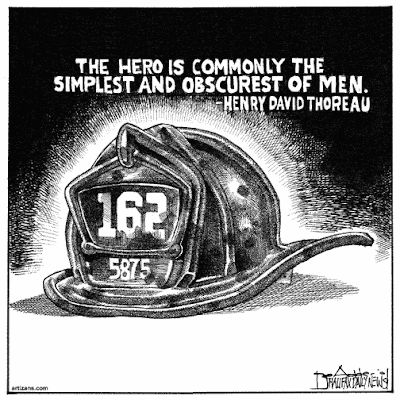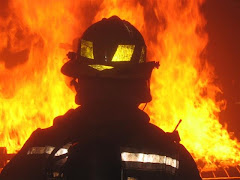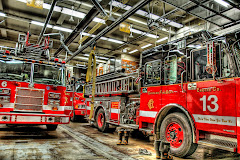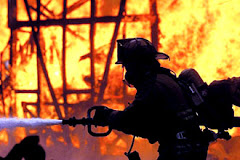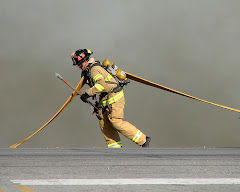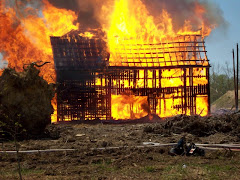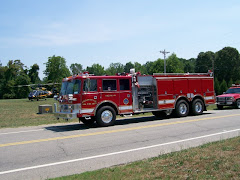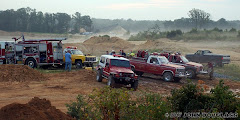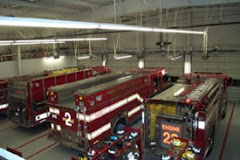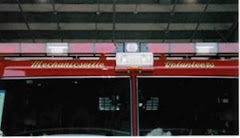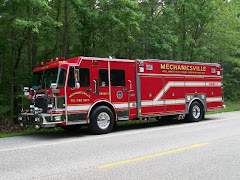1. You can tell what type of fire it is by the smell of smoke 10 miles away.
2. You have ever had a heated debate over the color of fire trucks.
3. You have ever spent 10 min trying to force open a door only to have someone come along and open it by turning the handle.
4. You have ever taken 10 or more showers in 1 day.
5. You lay out your cloths from that day so if there is a call at night you can find them quickly.
6. You take great joy in smashing the windows of a car parked in a fire zone or in front of a hydrant.
7. You have ever been airborne without an aircraft and water was your thrust.
8. You always wear red suspenders.
9. You have ever slept in a hosebed.
10. You carry a ton of specially modified tools in your pocket.
11. You ever cursed out someone for armor-alling the seats to make them look nice.
12. You’ve ever clung to the air horn chord for dear life because the driver is insane.
13. You have ever played jingle bells at Xmas time on the air horns to clear traffic.
14. You double your weight every time you go on a job a building.
15. You have ever said, "She’s hot tonight" and not been talking about a girl.
16. You have ever had "yoda ears"
17. You have ever called a person found after a fire a "crispy critter"
18. You have ever smoked and there wasn't a cigarette in sight.
19. You have ever stomped out a fire with your boots because you couldn't wait for water.
20. You have ever walked 3 miles into the woods in 100 degree heat in full turnout gear and a 5 gal or more water can strapped on your back just to put out a fire.
21. Your kids are afraid to get into water fights with you.
22. "Climbing the corporate ladder" has nothing to do with career advancement.
23. Your work gear makes you sound like Darth Vader.
24. You roll around in anything that just burned to make your new gear look old.
25. You take pride in the fact that you haven't washed your gear in years.
26. You carry enough in your pockets to give the Swiss army knives competition.
27. You carry enough in your car to extinguish a minor blaze.
28. You have ever juggled hot coals with your gloves.
29. Your own vehicle has more lights than a Christmas tree.
30. All the shirts you own say you are a firefighter.
31. You find yourself living at the fire department 365 days a year!
32. When you go to rent a movie, and they insist on getting Backdraft EVERY TIME!
33. At 3:00am you get back from a bad fire, you walk through the house and test the smoke alarms.
34. If you have more pagers than money in your wallet.
35. If you can’t walk through a building with out looking for the fire extinguisher.
36. If a great stop has nothing does with a moving vehicle.
37. If assembling a mile and a half of hose to catch fire in running up hill is a good day.
38. The microwave goes off and you run out of the house thinking it was your pager.
39. You ever tried to patent a 911 blocker with the phone Company
40. If you can hear that the siren will go off even before your dog notices it.
41. If you have ever woken up thinking your pager went off and as you look at it, it goes off
42. If you have ever tested your gloves by putting a fuzzie out on your hand.
43. If you have ever been awakened with a CO2 extinguisher
44. If you have ever dried your gloves on the trucks exhaust
45. You know you're a firefighter when you really think that rusty old hydrant looks good in the garden. :)
46. All your friends give you t-shirts from their departments for your birthday, Christmas, anniversary, etc.
47. If your wife voluntarily chooses the lumpy side of the bed to avoid being trampled in route to a call!
48. Your wife/girlfriend has learned to duck and cover when she hears the pager go off for fear of being run down.
49. If you had to extricate someone by cutting the car doors off on one side and realized there was nothing wrong with the doors on the other side.
50. If you have more toy fire trucks than your kids do.
51. When you have ever made a Jacuzzi out of a 2100 gallon dump tank and a rescue boat motor (15 horse Merc). ..It was hot!.............Watch yer toes!
52. When you take all of your important stuff (like wallets and pagers) out of your pockets before going to a training involving a portable tank.
Tuesday, September 25, 2007
Thursday, September 20, 2007
Sunday, September 16, 2007
Wednesday, September 12, 2007
Firehouse Humor
RAPID RESPONSE
Years ago, when I was working on a small town ambulance, it was not uncommon for my wife and me to stop at the local grocer to buy food for dinner after a call. I had gone in to get a head of lettuce and some apples. Unknown to me the floor was wet from the newly installed produce sprayers. Down I went, hitting my head hard. When I came to, the manager of the store was sitting beside me telling me not to move, that he had called 911. At the same time my pager went off and he looked at me and asked, “What was that? I said "My pager, I am 911." He looked at me, shocked " Boy, you guys are fast!"
The Ten Commandments of Rolling Code
1. Thou shall treat thy pumper as though it were your firstborn child.
2. Blow thy siren and shine thy light with great vigor enroute.
3. Know where thy goest at all times.
4. Be certain all those in attendance are affixed prior to venturing forth.
5. Thou shall arriveth shiny side up.
6. Be ever so humble when thy mic is keyed.
7. Thou salt not leave thy station 'til thy door is openeth.
8. Thou salt not closeth thy bay door too soon.
9. Thou salt closeth all compartment doors when thou art done.
10. Thou salt never chastise thy driver for making a wrong turn when it results in a return to the firehouse.
Firefighter Terminology
Haligan Tool: Used for breaking headlights
Water Hammer: Used to drive in water nails
Drafting: Following another fire engine really closely on the way to a fire
Backdraft: Drafting on the way back to the station
Ladder Company: Where they make ladders
Flashover: Too many lights on the pumper
Rollover: What you do in the ashes to make your new turnouts look old
Master Stream: The Mississippi River
BLEVE: It was dry when I drove my Chevy there
Mutual Aid: When 4 kids are hurt and there is only 3 band aids, someone is getting Mutual Aid
Firefighter911
Years ago, when I was working on a small town ambulance, it was not uncommon for my wife and me to stop at the local grocer to buy food for dinner after a call. I had gone in to get a head of lettuce and some apples. Unknown to me the floor was wet from the newly installed produce sprayers. Down I went, hitting my head hard. When I came to, the manager of the store was sitting beside me telling me not to move, that he had called 911. At the same time my pager went off and he looked at me and asked, “What was that? I said "My pager, I am 911." He looked at me, shocked " Boy, you guys are fast!"
The Ten Commandments of Rolling Code
1. Thou shall treat thy pumper as though it were your firstborn child.
2. Blow thy siren and shine thy light with great vigor enroute.
3. Know where thy goest at all times.
4. Be certain all those in attendance are affixed prior to venturing forth.
5. Thou shall arriveth shiny side up.
6. Be ever so humble when thy mic is keyed.
7. Thou salt not leave thy station 'til thy door is openeth.
8. Thou salt not closeth thy bay door too soon.
9. Thou salt closeth all compartment doors when thou art done.
10. Thou salt never chastise thy driver for making a wrong turn when it results in a return to the firehouse.
Firefighter Terminology
Haligan Tool: Used for breaking headlights
Water Hammer: Used to drive in water nails
Drafting: Following another fire engine really closely on the way to a fire
Backdraft: Drafting on the way back to the station
Ladder Company: Where they make ladders
Flashover: Too many lights on the pumper
Rollover: What you do in the ashes to make your new turnouts look old
Master Stream: The Mississippi River
BLEVE: It was dry when I drove my Chevy there
Mutual Aid: When 4 kids are hurt and there is only 3 band aids, someone is getting Mutual Aid
Firefighter911
Tuesday, September 11, 2007
Tuesday, September 4, 2007
343 FDNY Fire Fighters Who Died On 9/11
343 FDNY Fire Fighters Who Died On 9/11
Adam David Rand
Alan David Feinberg
Allan Tarasiewicz
Andre G. Fletcher
Andrew A. Fredericks
Andrew Brian Jordan, Sr.
Andrew Brunn
Andrew J. Desperito
Angel L. Juarbe, Jr.
Anthony Jovic
Anthony Rodriguez
Arthur T. Barry
Benjamin Suarez
Brian C. Hickey
Brian Cannizzaro
Brian E. Bilcher
Brian E. Sweeney
Brian G. Ahearn
Brian G. McAleese
Bruce H. Gary
Calixto Anaya, Jr.
Carl E. Molinaro
Carl F. Asaro
Carl J. Bedigian
Carl V. Bini
Carlos Lillo
Charles J. Margiotta
Charles L. Kasper
Charles R. Mendez
Charles W. Garbarini
Christian Michael Otto Regenhard
Christopher Alexandra Santora
Christopher J. Blackwell
Christopher James Pickford
Christopher M. Mozzillo
Christopher P. Sullivan
Dana Rey Hannon
Daniel E. Harlin
Daniel F. Libretti
Daniel J. Brethel
Daniel O'Callaghan
Daniel T. Suhr
David Fontana
David G. Arce
David Halderman
David J. La Forge
David M. Weiss
David P. DeRubbio
David T. Wooley
Denis P. Germain
Dennis A. Cross
Dennis Lawrence Devlin
Dennis M. Carey, Sr.
Dennis M. Mulligan
Dennis Mojica
Dennis P. McHugh
Dennis P. Oberg
Dennis Scauso
Donald J. Burns
Donald J. Regan
Douglas C. Miller
Douglas E. Oelschlager
Durrell V. Pearsall
Edward Alexander D'Atri
Edward F. Geraghty
Edward J. Day
Edward J. Rall
Edward J. White, III
Eric T. Allen
Eric Taube Olsen
Eugene M. Whelan
Faustino Apostol
Fr. Mychal Judge
Frank Anthony Palombo
Frank J. Bonomo
Frank J. Callahan
Frankie Esposito
Fred C. Scheffold
Frederick J. Ill, Jr.
Gary P. Geidel
Gary R. Box
Geoffrey E. Guja
George C. Cain
George DiPasquale
Gerald T. Atwood
Gerard A. Barbara
Gerard Baptiste
Gerard J. Duffy
Gerard P. Dewan
Gerard P. Schrang
Gerard T. Nevins
Glenn C. Perry
Glenn E. Wilkinson
Gregg A. Atlas
Gregory J. Buck
Gregory M. Stajk
Gregory R. Sikorsky
Gregory Saucedo
Harvey L. Harrell
Hector L. Tirado, Jr.
Henry A. Miller, Jr.
James A. Giberson
James Amato
James M. Gray
James N. Pappageorge
James Raymond Coyle
Jay Ogren
Jeff Palazzo
Jeffrey J. Giordano
Jeffrey J. Olsen
Jeffrey P. Walz
Jeffrey Stark
Jimmy Riches
John A. Crisci
John A. Schardt
John August Santore
John Chipura
John D. Marshall
John F. Ginley
John Heffernan
John J. Fanning
John J. Florio
John J. Giordano
John J. Tipping, II
John K. McAvoy
John M. Collins
John M. Moran
John M. Paolillo
John P. Bergin
John P. Burnside
John P. Napolitano
John P. Williamson
John Patrick Tierney
John R. Fischer
John T. Vigiano II
Jonathan L. Ielpi
Jonathan R. Hohmann
Jose A. Guadalupe
Joseph Agnello
Joseph Angelini, Sr.
Joseph Anthony Mascali
Joseph D. Farrelly
Joseph E. Maloney
Joseph G. Hunter
Joseph G. Leavey
Joseph Grzelak
Joseph J. Angelini, Jr.
Joseph Maffeo
Joseph P. Gullickson
Joseph P. Henry
Joseph P. Spor
Joseph R. Marchbanks, Jr.
Joseph R. Rivelli, Jr.
Karl H. Joseph
Keith A. Glascoe
Keithroy Marcellus Maynard
Kenneth B. Kumpel
Kenneth J. Marino
Kenneth J. Phelan, Sr.
Kenneth T. Watson
Kevin C. Dowdell
Kevin H. Bracken
Kevin J. Pfeifer
Kevin J. Smith
Kevin M. O'Rourke
Kevin M. Prior
Kevin O. Reilly
Kevin W. Donnelly
Lawrence G. Veling
Lawrence J. Virgilio
Lawrence T. Stack
Lee S. Fehling
Lenny Ragaglia
Leon Smith, Jr.
Lincoln Quappe
Louis Arena
Louis J. Modafferi
Manuel Del Valle, Jr.
Manuel Mojica
Mark P. Whitford
Martin E. McWilliams
Martin J. Egan, Jr.
Martin N. DeMeo
Matthew D. Garvey
Matthew E. Barnes
Matthew L. Ryan
Matthew S. Rogan
Michael A. Esposito
Michael Boyle
Michael C. Fiore
Michael Clarke
Michael D. D'Auria
Michael Dermott Mullan
Michael E. Brennan
Michael E. Roberts
Michael Edward Roberts
Michael F. Cammarata
Michael F. Lynch
Michael Francis Lynch
Michael G. Montesi
Michael H. Haub
Michael J. Cawley
Michael J. Elferis
Michael J. Lyons
Michael J. Otten
Michael K. Healey
Michael L. Bocchino
Michael N. Fodor
Michael Paul Ragusa
Michael Scott Carlo
Michael T. Carroll
Michael T. Quilty
Michael T. Russo
Michael Thomas Weinberg
Michael Vernon Kiefer
Michael Warchola
Neil Joseph Leavy
Nicholas P. Chiofalo
Nicholas P. Rossomando
Orio Joseph Palmer
Patrick D. Byrne
Patrick J. Brown
Patrick J. Lyons
Patrick J. O'Keefe
Patrick J. Waters
Paul A. Tegtmeier
Paul G. Ruback
Paul Hanlon Keating
Paul J. Gill
Paul J. Pansini
Paul M. Beyer
Paul Richard Martini
Paul Thomas Mitchell
Peter A. Bielfeld
Peter A. Nelson
Peter Anthony Vega
Peter Brennan
Peter C. Martin
Peter J. Carroll
Peter J. Ganci, Jr.
Peter L. Freund
Peter Langone
Philip S. Petti
R. Bruce Van Hine
Raymond E. Murphy
Raymond M. Downey
Raymond Meisenheimer
Raymond R. York
Ricardo Joseph Quinn
Richard A. Prunty
Richard D. Allen
Richard J. Kelly, Jr.
Richard T. Muldowney, Jr.
Robert B. Nagel
Robert C. King, Jr.
Robert Cordice
Robert Curatolo
Robert Dismas McMahon
Robert E. Parro
Robert Edward Evans
Robert F. Wallace
Robert J. Crawford
Robert J. Foti
Robert J. Minara
Robert M. Regan
Robert T. Lane
Robert T. Linnane
Robert W. Hamilton
Robert W. Spear, Jr.
Robert William McPadden
Ronald P. Bucca
Ronald T. Kerwin
Ronnie E. Gies
Ronnie L. Henderson
Ruben D. Correa
Salvatore Calabro
Samuel P. Oitice
Scott Andrew Larsen
Scott Matthew Davidson
Scott Michael Kopytko
Sean Patrick Tallon
Sean S. Hanley
Sergio G. Villanueva
Shawn Edward Powell
Stanley S. Smagala, Jr.
Stephen E. Belson
Stephen G. Harrell
Stephen G. Siller
Stephen P. Russell
Steve J. Mercado
Steven Coakley
Steven J. Bates
Steven J. Olson
Tarel Coleman
Terence Augustine McShane
Terence S. Hatton
Terrace P. Farrell
Thomas A. Casoria
Thomas A. Gardner
Thomas C. Moody
Thomas E. Sabella
Thomas G. O'Hagan
Thomas Gambino, Jr.
Thomas Gerard Schoales
Thomas Haskell, Jr.
Thomas J. Farino
Thomas J. Foley
Thomas J. Hetzel
Thomas J. Kennedy
Thomas J. Kuveikis
Thomas J. McCann
Thomas M. Butler
Thomas Mingione
Thomas P. DeAngelis
Thomas P. Hannafin
Thomas P. Holohan
Thomas Patrick Cullen, III
Thomas Richard Kelly
Thomas W. Kelly
Timothy Brian Higgins
Timothy M. Stackpole
Timothy M. Welty
Timothy Patrick McSweeney
Timothy S. Haskell
Vernon A. Richard
Vernon P. Cherry
Vincent A. Princiotta
Vincent D. Kane
Vincent E. Brunton
Vincent F. Giammona
Vincent G. Halloran
Vincent S. Morello
Walter G. Hynes
William D. Lake
William E. Krukowski
William E. McGinn
William F. Burke, Jr.
William J. Mahoney, II
William L. Henry, Jr.
William M. Feehan
William McGovern
William R. Johnston
William S. O'Keefe
Forever in our Hearts
Adam David Rand
Alan David Feinberg
Allan Tarasiewicz
Andre G. Fletcher
Andrew A. Fredericks
Andrew Brian Jordan, Sr.
Andrew Brunn
Andrew J. Desperito
Angel L. Juarbe, Jr.
Anthony Jovic
Anthony Rodriguez
Arthur T. Barry
Benjamin Suarez
Brian C. Hickey
Brian Cannizzaro
Brian E. Bilcher
Brian E. Sweeney
Brian G. Ahearn
Brian G. McAleese
Bruce H. Gary
Calixto Anaya, Jr.
Carl E. Molinaro
Carl F. Asaro
Carl J. Bedigian
Carl V. Bini
Carlos Lillo
Charles J. Margiotta
Charles L. Kasper
Charles R. Mendez
Charles W. Garbarini
Christian Michael Otto Regenhard
Christopher Alexandra Santora
Christopher J. Blackwell
Christopher James Pickford
Christopher M. Mozzillo
Christopher P. Sullivan
Dana Rey Hannon
Daniel E. Harlin
Daniel F. Libretti
Daniel J. Brethel
Daniel O'Callaghan
Daniel T. Suhr
David Fontana
David G. Arce
David Halderman
David J. La Forge
David M. Weiss
David P. DeRubbio
David T. Wooley
Denis P. Germain
Dennis A. Cross
Dennis Lawrence Devlin
Dennis M. Carey, Sr.
Dennis M. Mulligan
Dennis Mojica
Dennis P. McHugh
Dennis P. Oberg
Dennis Scauso
Donald J. Burns
Donald J. Regan
Douglas C. Miller
Douglas E. Oelschlager
Durrell V. Pearsall
Edward Alexander D'Atri
Edward F. Geraghty
Edward J. Day
Edward J. Rall
Edward J. White, III
Eric T. Allen
Eric Taube Olsen
Eugene M. Whelan
Faustino Apostol
Fr. Mychal Judge
Frank Anthony Palombo
Frank J. Bonomo
Frank J. Callahan
Frankie Esposito
Fred C. Scheffold
Frederick J. Ill, Jr.
Gary P. Geidel
Gary R. Box
Geoffrey E. Guja
George C. Cain
George DiPasquale
Gerald T. Atwood
Gerard A. Barbara
Gerard Baptiste
Gerard J. Duffy
Gerard P. Dewan
Gerard P. Schrang
Gerard T. Nevins
Glenn C. Perry
Glenn E. Wilkinson
Gregg A. Atlas
Gregory J. Buck
Gregory M. Stajk
Gregory R. Sikorsky
Gregory Saucedo
Harvey L. Harrell
Hector L. Tirado, Jr.
Henry A. Miller, Jr.
James A. Giberson
James Amato
James M. Gray
James N. Pappageorge
James Raymond Coyle
Jay Ogren
Jeff Palazzo
Jeffrey J. Giordano
Jeffrey J. Olsen
Jeffrey P. Walz
Jeffrey Stark
Jimmy Riches
John A. Crisci
John A. Schardt
John August Santore
John Chipura
John D. Marshall
John F. Ginley
John Heffernan
John J. Fanning
John J. Florio
John J. Giordano
John J. Tipping, II
John K. McAvoy
John M. Collins
John M. Moran
John M. Paolillo
John P. Bergin
John P. Burnside
John P. Napolitano
John P. Williamson
John Patrick Tierney
John R. Fischer
John T. Vigiano II
Jonathan L. Ielpi
Jonathan R. Hohmann
Jose A. Guadalupe
Joseph Agnello
Joseph Angelini, Sr.
Joseph Anthony Mascali
Joseph D. Farrelly
Joseph E. Maloney
Joseph G. Hunter
Joseph G. Leavey
Joseph Grzelak
Joseph J. Angelini, Jr.
Joseph Maffeo
Joseph P. Gullickson
Joseph P. Henry
Joseph P. Spor
Joseph R. Marchbanks, Jr.
Joseph R. Rivelli, Jr.
Karl H. Joseph
Keith A. Glascoe
Keithroy Marcellus Maynard
Kenneth B. Kumpel
Kenneth J. Marino
Kenneth J. Phelan, Sr.
Kenneth T. Watson
Kevin C. Dowdell
Kevin H. Bracken
Kevin J. Pfeifer
Kevin J. Smith
Kevin M. O'Rourke
Kevin M. Prior
Kevin O. Reilly
Kevin W. Donnelly
Lawrence G. Veling
Lawrence J. Virgilio
Lawrence T. Stack
Lee S. Fehling
Lenny Ragaglia
Leon Smith, Jr.
Lincoln Quappe
Louis Arena
Louis J. Modafferi
Manuel Del Valle, Jr.
Manuel Mojica
Mark P. Whitford
Martin E. McWilliams
Martin J. Egan, Jr.
Martin N. DeMeo
Matthew D. Garvey
Matthew E. Barnes
Matthew L. Ryan
Matthew S. Rogan
Michael A. Esposito
Michael Boyle
Michael C. Fiore
Michael Clarke
Michael D. D'Auria
Michael Dermott Mullan
Michael E. Brennan
Michael E. Roberts
Michael Edward Roberts
Michael F. Cammarata
Michael F. Lynch
Michael Francis Lynch
Michael G. Montesi
Michael H. Haub
Michael J. Cawley
Michael J. Elferis
Michael J. Lyons
Michael J. Otten
Michael K. Healey
Michael L. Bocchino
Michael N. Fodor
Michael Paul Ragusa
Michael Scott Carlo
Michael T. Carroll
Michael T. Quilty
Michael T. Russo
Michael Thomas Weinberg
Michael Vernon Kiefer
Michael Warchola
Neil Joseph Leavy
Nicholas P. Chiofalo
Nicholas P. Rossomando
Orio Joseph Palmer
Patrick D. Byrne
Patrick J. Brown
Patrick J. Lyons
Patrick J. O'Keefe
Patrick J. Waters
Paul A. Tegtmeier
Paul G. Ruback
Paul Hanlon Keating
Paul J. Gill
Paul J. Pansini
Paul M. Beyer
Paul Richard Martini
Paul Thomas Mitchell
Peter A. Bielfeld
Peter A. Nelson
Peter Anthony Vega
Peter Brennan
Peter C. Martin
Peter J. Carroll
Peter J. Ganci, Jr.
Peter L. Freund
Peter Langone
Philip S. Petti
R. Bruce Van Hine
Raymond E. Murphy
Raymond M. Downey
Raymond Meisenheimer
Raymond R. York
Ricardo Joseph Quinn
Richard A. Prunty
Richard D. Allen
Richard J. Kelly, Jr.
Richard T. Muldowney, Jr.
Robert B. Nagel
Robert C. King, Jr.
Robert Cordice
Robert Curatolo
Robert Dismas McMahon
Robert E. Parro
Robert Edward Evans
Robert F. Wallace
Robert J. Crawford
Robert J. Foti
Robert J. Minara
Robert M. Regan
Robert T. Lane
Robert T. Linnane
Robert W. Hamilton
Robert W. Spear, Jr.
Robert William McPadden
Ronald P. Bucca
Ronald T. Kerwin
Ronnie E. Gies
Ronnie L. Henderson
Ruben D. Correa
Salvatore Calabro
Samuel P. Oitice
Scott Andrew Larsen
Scott Matthew Davidson
Scott Michael Kopytko
Sean Patrick Tallon
Sean S. Hanley
Sergio G. Villanueva
Shawn Edward Powell
Stanley S. Smagala, Jr.
Stephen E. Belson
Stephen G. Harrell
Stephen G. Siller
Stephen P. Russell
Steve J. Mercado
Steven Coakley
Steven J. Bates
Steven J. Olson
Tarel Coleman
Terence Augustine McShane
Terence S. Hatton
Terrace P. Farrell
Thomas A. Casoria
Thomas A. Gardner
Thomas C. Moody
Thomas E. Sabella
Thomas G. O'Hagan
Thomas Gambino, Jr.
Thomas Gerard Schoales
Thomas Haskell, Jr.
Thomas J. Farino
Thomas J. Foley
Thomas J. Hetzel
Thomas J. Kennedy
Thomas J. Kuveikis
Thomas J. McCann
Thomas M. Butler
Thomas Mingione
Thomas P. DeAngelis
Thomas P. Hannafin
Thomas P. Holohan
Thomas Patrick Cullen, III
Thomas Richard Kelly
Thomas W. Kelly
Timothy Brian Higgins
Timothy M. Stackpole
Timothy M. Welty
Timothy Patrick McSweeney
Timothy S. Haskell
Vernon A. Richard
Vernon P. Cherry
Vincent A. Princiotta
Vincent D. Kane
Vincent E. Brunton
Vincent F. Giammona
Vincent G. Halloran
Vincent S. Morello
Walter G. Hynes
William D. Lake
William E. Krukowski
William E. McGinn
William F. Burke, Jr.
William J. Mahoney, II
William L. Henry, Jr.
William M. Feehan
William McGovern
William R. Johnston
William S. O'Keefe
Forever in our Hearts
Tuesday, August 28, 2007
Suppressing the fuel and the energy
Use of water
Often, the main way to extinguish a fire is to spray with water. The water has two roles:
in contact with the fire, it vaporizes, and this vapour displaces the oxygen (the volume of water vapour is 1,700 times greater than liquid water); leaving the fire with not enough combustive agent to continue, and it dies out.
the vaporization of water absorbs the heat; it cools the smoke, air, walls, objects in the room, etc., that could act as further fuel, and thus prevents one of the means that fires grow, which is by "jumping" to nearby heat/fuel sources to start new fires, which then combine.
The extinction is thus a combination of "asphyxia" and cooling. The flame itself is suppressed by asphyxia, but the cooling is the most important element to master a fire in a closed area.
Open volume fire
For fires in the open, the seat of the fire is sprayed with a straight spray: the cooling effect immediately follows the "asphyxia" by vapor, and reduces the amount of water required. A straight stream (or solid spray) is used so the water arrives massively to the seat of the fire without being vaporized. A high presure spray may also have a mechanical effect: it can disperse the combustible product and thus prevent the fire from starting again.
Spray is aimed at a surface, or object: for this reason, the strategy is sometimes called two-dimensional attack or 2D attack.
It might be necessary to protect specific structures (house, gas tank) against infrared radiation, and thus use a fog patern (or diffused spray) between the fire and the object.
Closed volume fire
Until the 1970s, building fires were usually attacked form the outside, so the same strategy as for open air fires was effective. In recent times, fires are now attacked form the inside during their development phase. Interior attack is commen now because; firefighters can arrive sooner, thermal insulation of houses confines the heat to the inside, and firefighters have equipment that allows them to work inside a burning building(i.e. SCBA, turnout gear...). Additionally, in these conditions, there is a greater risk of backdraft and of flashover.
Spraying of the seat of the fire directly can have unfortunate and dramatic consequences: the water pushes air in front of it, so the fire is supplied with extra oxygen before the water reaches it. This activation of the fire, and the mixing of the gases produced by the water flow, can create a flashover.
The most important issue is not the flames, but control of the fire, i.e. the cooling of the smoke that can spread and start distant fires, and that endanger the lives of people, including firefighters. The volume must be cooled before the seat is treated. This strategy originally of Swedish (Mats Rosander & Krister Giselsson) origin, was further adapted by London Fire Officer Paul Grimwood following a decade of operational use in London's busy west-end district between 1984-94 and termed three-dimensional attack, or 3D attack.
Use of a fog patern (or diffused spray) was first proposed by Chief Lloyd Layman of Parkersburg, West Virginia Fire Department, at the Fire Department Instructor's Conference (FDIC) in 1950 held in Memphis, Tennessee, U.S.A.
Using Grimwood's modified '3D attack strategy' the ceiling is first sprayed with short pulses of a diffused spray:
it cools the smoke, thus the smoke is less likely to start a fire when it moves away;
the pressure of the gas drops when it cools (law of ideal gases), thus it also reduces the mobility of the smoke and avoids a "backfire" of water vapour;
it creates an inert "water vapour sky" which prevents roll-over (rolls of flames on the ceiling created by the burning of hot gases).
Only short pulses of water must be sprayed, otherwise the spraying modifies the equilibrium, and the gases mix instead of remaining stratified: the hot gases (initially at the ceiling) move around the room and the temperature rises at the ground, which is dangerous for firefighters. An alternative is to cool all the atmosphere by spraying the whole atmosphere as if drawing letters in the air ("pencilling").
The modern methods for an urban fire dictate the use of a massive initial water flow, e.g. 50 gallons/min for each fire hose. The aim is to absorb as much heat as possible at the beginning to stop the expansion of the fire, and to reduce the smoke. When the flow is too small, the cooling is not sufficient, and the steam that is produced can burn firefighters (the drop of pressure is too small and the vapor is pushed back). Although it may seem paradoxical, the use of a strong flow with an efficient fire hose and an efficient strategy (diffused sprayed, small droplets) requires a smaller amount of water: once the temperature is lowered, only a limited amount of water is necessary to suppress the fire seat with a straight spray. For a living room of 50 m² (60 square yards), the required amount of water is estimated as 15 gallons.
French fire-fighters used an alternative method in the 1970s: they sprayed water on the hot walls to create a water vapour atmosphere and asphyxiate the fire. This method is no longer used because it was risky: the pressure created pushed the hot gases and vapour towards the firefighters, causing severe burns, and pushed the hot gases into other rooms where they could start a new fire.
Asphyxiating a fire
In some cases, the use of water is undesirable: some chemical products react with water and produce poisonous gases, or even burn in contact with water (e.g. sodium);
some products float on water, e.g. hydrocarbon (gasoline, oil, alcohol, etc.); a burning layer can then spread and extend;
in case of a pressurised gas tank, it is necessary to avoid heat shocks that may damage the tank: the resulting decompression may produce a BLEVE.
It is then necessary to asphyxiate the fire. This can be done in two ways:
some chemical products react with the fuel and stop the combustion;
a layer of water-based fire retardant foam is projected on the product by the fire hose, to keep the oxygen in air separated from the fuel.
wikipedia.org
Often, the main way to extinguish a fire is to spray with water. The water has two roles:
in contact with the fire, it vaporizes, and this vapour displaces the oxygen (the volume of water vapour is 1,700 times greater than liquid water); leaving the fire with not enough combustive agent to continue, and it dies out.
the vaporization of water absorbs the heat; it cools the smoke, air, walls, objects in the room, etc., that could act as further fuel, and thus prevents one of the means that fires grow, which is by "jumping" to nearby heat/fuel sources to start new fires, which then combine.
The extinction is thus a combination of "asphyxia" and cooling. The flame itself is suppressed by asphyxia, but the cooling is the most important element to master a fire in a closed area.
Open volume fire
For fires in the open, the seat of the fire is sprayed with a straight spray: the cooling effect immediately follows the "asphyxia" by vapor, and reduces the amount of water required. A straight stream (or solid spray) is used so the water arrives massively to the seat of the fire without being vaporized. A high presure spray may also have a mechanical effect: it can disperse the combustible product and thus prevent the fire from starting again.
Spray is aimed at a surface, or object: for this reason, the strategy is sometimes called two-dimensional attack or 2D attack.
It might be necessary to protect specific structures (house, gas tank) against infrared radiation, and thus use a fog patern (or diffused spray) between the fire and the object.
Closed volume fire
Until the 1970s, building fires were usually attacked form the outside, so the same strategy as for open air fires was effective. In recent times, fires are now attacked form the inside during their development phase. Interior attack is commen now because; firefighters can arrive sooner, thermal insulation of houses confines the heat to the inside, and firefighters have equipment that allows them to work inside a burning building(i.e. SCBA, turnout gear...). Additionally, in these conditions, there is a greater risk of backdraft and of flashover.
Spraying of the seat of the fire directly can have unfortunate and dramatic consequences: the water pushes air in front of it, so the fire is supplied with extra oxygen before the water reaches it. This activation of the fire, and the mixing of the gases produced by the water flow, can create a flashover.
The most important issue is not the flames, but control of the fire, i.e. the cooling of the smoke that can spread and start distant fires, and that endanger the lives of people, including firefighters. The volume must be cooled before the seat is treated. This strategy originally of Swedish (Mats Rosander & Krister Giselsson) origin, was further adapted by London Fire Officer Paul Grimwood following a decade of operational use in London's busy west-end district between 1984-94 and termed three-dimensional attack, or 3D attack.
Use of a fog patern (or diffused spray) was first proposed by Chief Lloyd Layman of Parkersburg, West Virginia Fire Department, at the Fire Department Instructor's Conference (FDIC) in 1950 held in Memphis, Tennessee, U.S.A.
Using Grimwood's modified '3D attack strategy' the ceiling is first sprayed with short pulses of a diffused spray:
it cools the smoke, thus the smoke is less likely to start a fire when it moves away;
the pressure of the gas drops when it cools (law of ideal gases), thus it also reduces the mobility of the smoke and avoids a "backfire" of water vapour;
it creates an inert "water vapour sky" which prevents roll-over (rolls of flames on the ceiling created by the burning of hot gases).
Only short pulses of water must be sprayed, otherwise the spraying modifies the equilibrium, and the gases mix instead of remaining stratified: the hot gases (initially at the ceiling) move around the room and the temperature rises at the ground, which is dangerous for firefighters. An alternative is to cool all the atmosphere by spraying the whole atmosphere as if drawing letters in the air ("pencilling").
The modern methods for an urban fire dictate the use of a massive initial water flow, e.g. 50 gallons/min for each fire hose. The aim is to absorb as much heat as possible at the beginning to stop the expansion of the fire, and to reduce the smoke. When the flow is too small, the cooling is not sufficient, and the steam that is produced can burn firefighters (the drop of pressure is too small and the vapor is pushed back). Although it may seem paradoxical, the use of a strong flow with an efficient fire hose and an efficient strategy (diffused sprayed, small droplets) requires a smaller amount of water: once the temperature is lowered, only a limited amount of water is necessary to suppress the fire seat with a straight spray. For a living room of 50 m² (60 square yards), the required amount of water is estimated as 15 gallons.
French fire-fighters used an alternative method in the 1970s: they sprayed water on the hot walls to create a water vapour atmosphere and asphyxiate the fire. This method is no longer used because it was risky: the pressure created pushed the hot gases and vapour towards the firefighters, causing severe burns, and pushed the hot gases into other rooms where they could start a new fire.
Asphyxiating a fire
In some cases, the use of water is undesirable: some chemical products react with water and produce poisonous gases, or even burn in contact with water (e.g. sodium);
some products float on water, e.g. hydrocarbon (gasoline, oil, alcohol, etc.); a burning layer can then spread and extend;
in case of a pressurised gas tank, it is necessary to avoid heat shocks that may damage the tank: the resulting decompression may produce a BLEVE.
It is then necessary to asphyxiate the fire. This can be done in two ways:
some chemical products react with the fuel and stop the combustion;
a layer of water-based fire retardant foam is projected on the product by the fire hose, to keep the oxygen in air separated from the fuel.
wikipedia.org
Subscribe to:
Comments (Atom)

